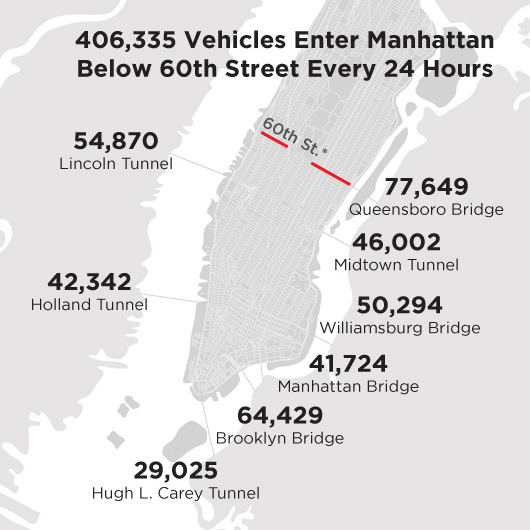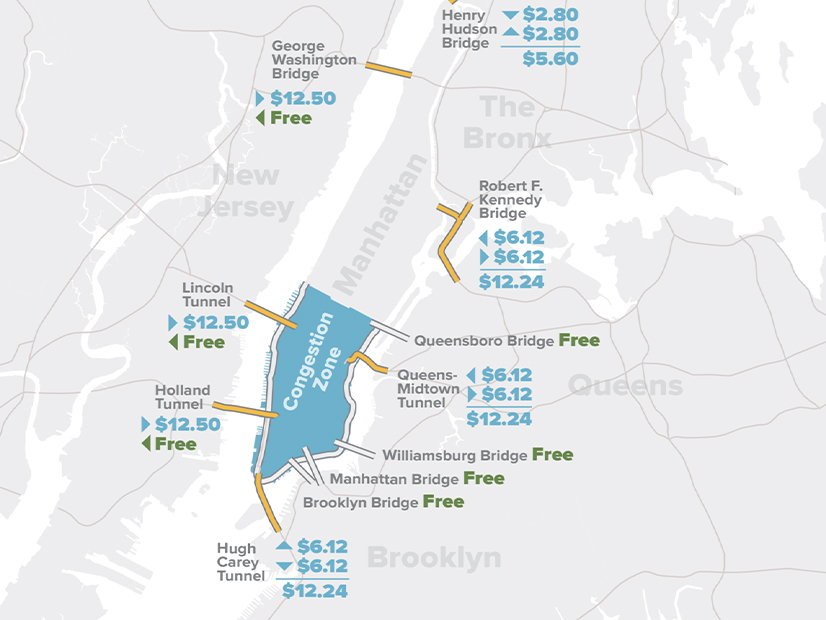The Federal Highway Administration (FHWA) on Friday approved the environmental assessment for New York City’s proposed congestion pricing plan, setting up the Big Apple to be the nation’s first city to implement a tolling program.
The city’s proposed Central Business District Tolling Program (CBDTP) would electronically charge motorists entering Manhattan below 60th Street, with the goal of both reducing city pollution and generating revenue to fund improvements to the Metropolitan Transportation Authority (MTA). (See NYC Traffic Congestion Pricing Aims to Tackle Climate, Enflames Emotions.) Tolls would be placed on vehicles entering or staying in the city’s Central Business District, excluding main throughways like the Franklin D. Roosevelt East River Drive or the Battery Park Underpass.
 Daily vehicle entry into Manhattan | NYC DOT
Daily vehicle entry into Manhattan | NYC DOT
The FHWA’s issuance of a Letter of Legal Sufficiency indicated that its environmental review found no significant impact on the surrounding metropolitan area. There will be a 30-day period for public comment on the EA before the city can move ahead.
Final congestion prices will be based on future recommendations from the six-person Traffic Mobility Review Board, but fares during peak traffic hours for passenger cars could be as high as $23 and $82 for trucks.
The MTA estimates that the CBDTP will generate up to $1 billion annually; significantly reduce traffic into Manhattan and city pollution by up to 12%; increase public transportation usage; save pedestrian lives by decreasing vehicle travel speeds; and not hurt disadvantaged communities, as residents making less than $60,000 would be exempt.
Although the CBDTP would be first of its kind in the U.S., similar efforts have been successfully implemented in cities around the world, such as Stockholm, London and Singapore.
Reaction Depends on Geography
The news was met with mixed reactions, based mostly on where in the metro area they came from.
New Jersey Gov. Phil Murphy was among the most forceful voices disapproving of the decision.
“Today’s decision by the U.S. Department of Transportation to allow New York’s congestion pricing plan to move forward is unfair and ill advised” and “undercuts some of the [Biden] administration’s own long-term goals,” the governor said in a statement. He added that his administration is “closely assessing all legal options.”
U.S. Reps. Nicole Malliotakis (R-N.Y.), whose district covers Staten Island and South Brooklyn, and Josh Gottheimer (D-N.J.), whose district covers the entire northern New Jersey-New York border, recently created the bipartisan Congressional Anti-Congestion Tax Caucus to combat the CBDTP.
Gottheimer said the caucus would “stand up for hardworking New Jersey and New York drivers who will soon face the MTA’s $23/day cash-grabbing congestion tax.” Malliotakis said “congestion pricing would shift vehicle traffic from higher-income, more urbanized areas to lower-income, more vulnerable communities.”
In a statement Friday, Gottheimer said, “The fight is just beginning.”
Rep. Anthony D’Esposito (R-N.Y.), who represents parts of Long Island, also expressed discomfort with the news, tweeting that the “congestion plan is a tax on hardworking New Yorkers who commute into New York City” and is “the wrong decision.”
Meanwhile, multiple outlets quoted a spokesperson for New York Gov. Kathy Hochul as saying her administration “is committed to implementing congestion pricing to reduce traffic, improve air quality and support our public transit system.”
“The finding of legal sufficiency is a critical step that will allow our environmental assessment to be publicly available for anyone to read, and we will continue to work with our partners to move congestion pricing forward,” Hochul said.
New York Mayor Eric Adams also expressed support, tweeting that the CBDTP “is about more than reducing traffic” and will “invest in our transit system and clean up the air in the most polluted communities.”
In a statement to NetZero Insider, Brooklyn Borough President Antonio Reynoso said, “So long as we do it right, congestion pricing will be a win-win-win for our economy, environment and people.”
 Visualization of New York’s current unequal toll rates | Regional Plan Association
Visualization of New York’s current unequal toll rates | Regional Plan Association
“Our next priority as we move forward with this landmark program is ensuring that we equalize tolls in a way that safeguards against toll-shopping and the overburdening of surrounding communities with traffic and pollution.”
Multiple Democratic members of the U.S. House of Representatives whose districts cover the city also support the plan, including Ritchie Torres (South Bronx), Jerry Nadler (central Manhattan) and Dan Goldman (Lower Manhattan and western Brooklyn).


